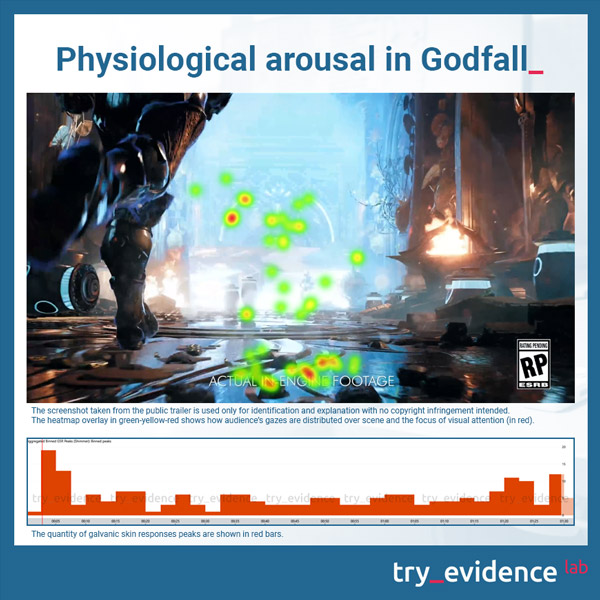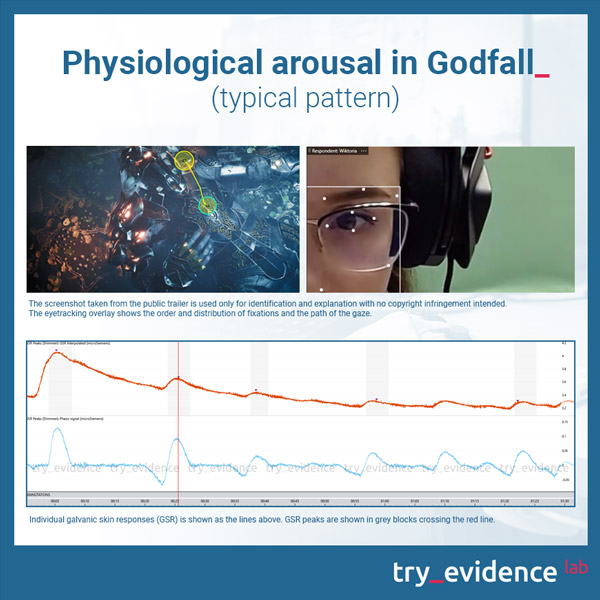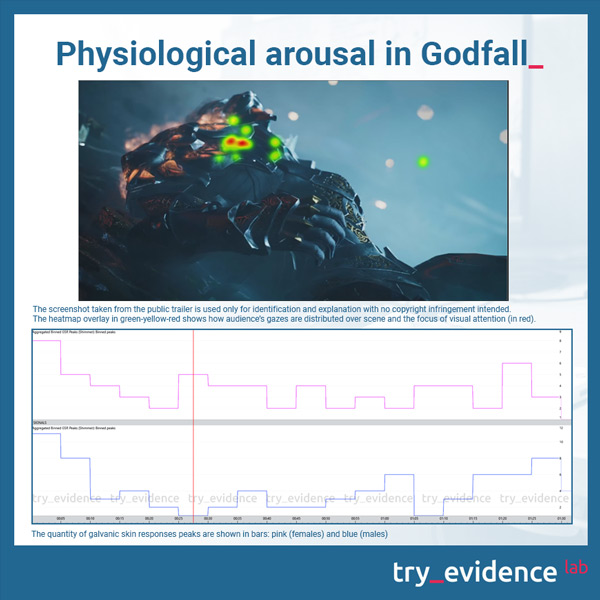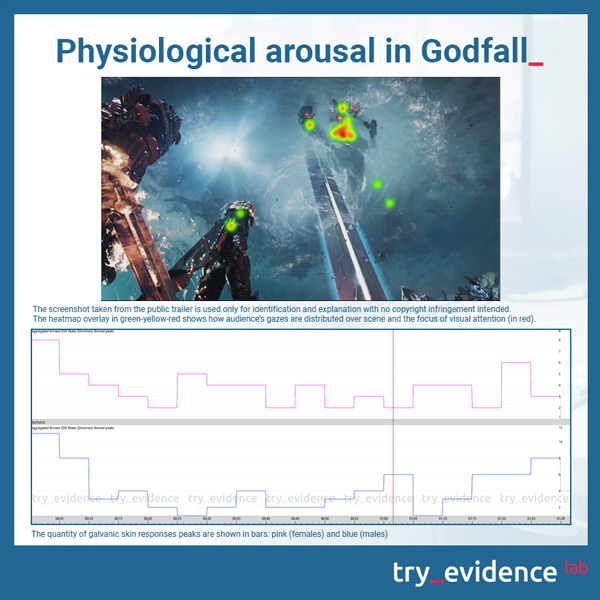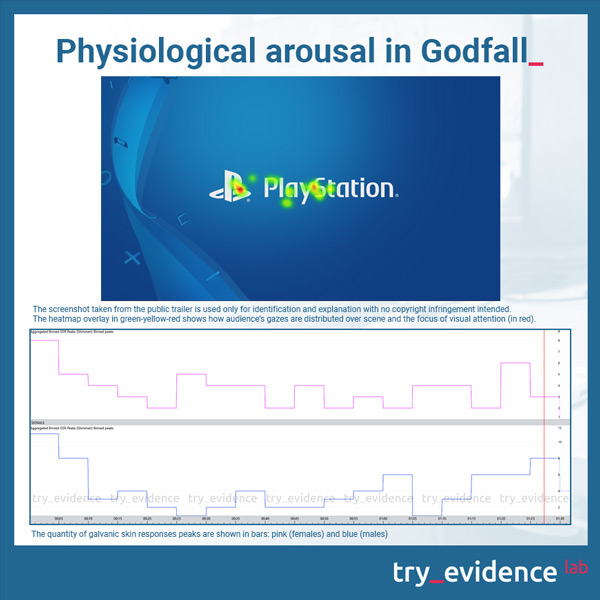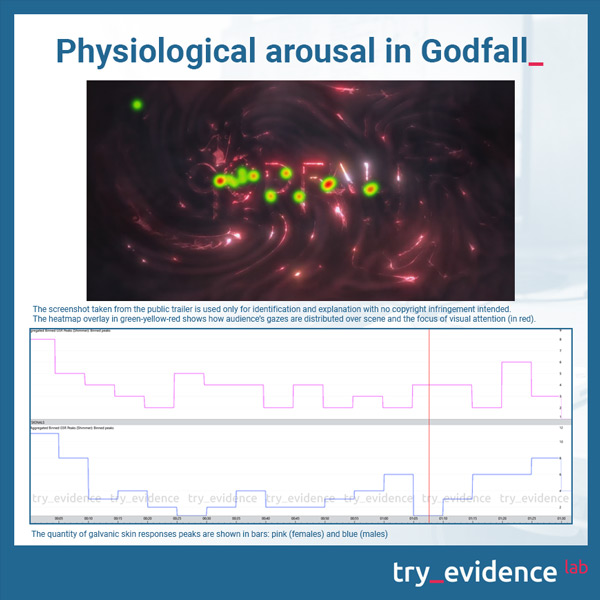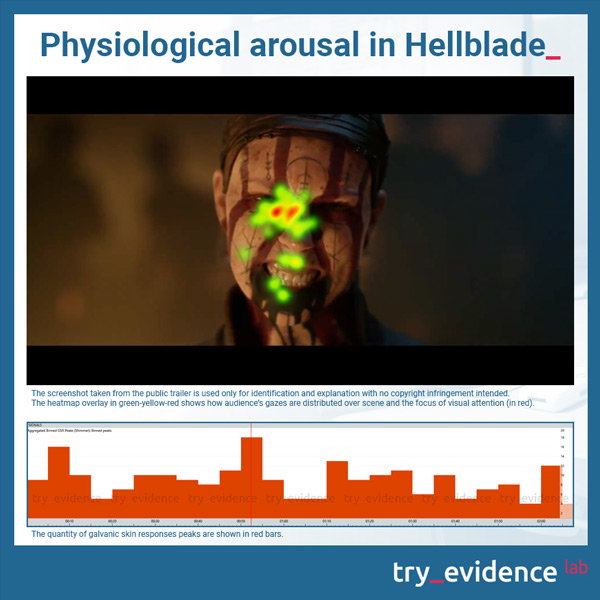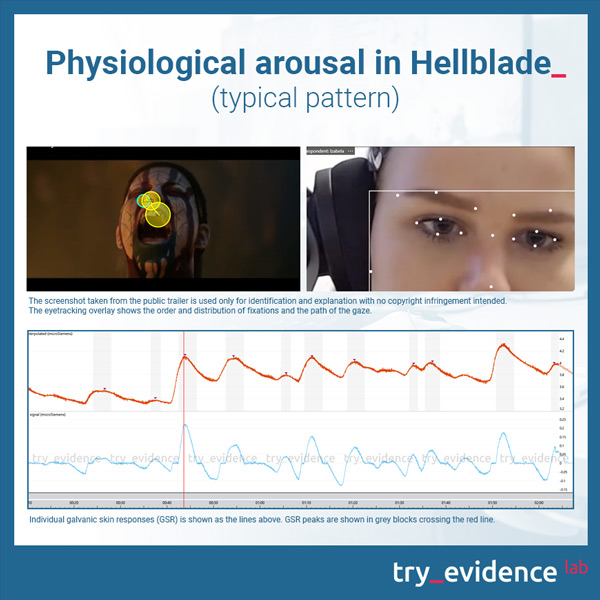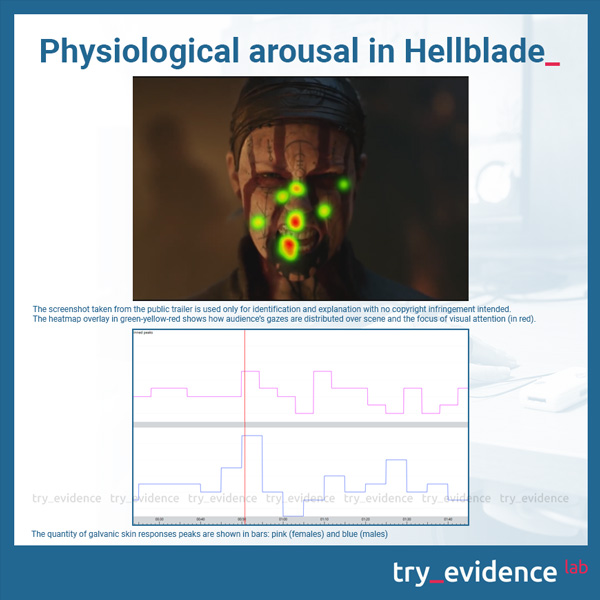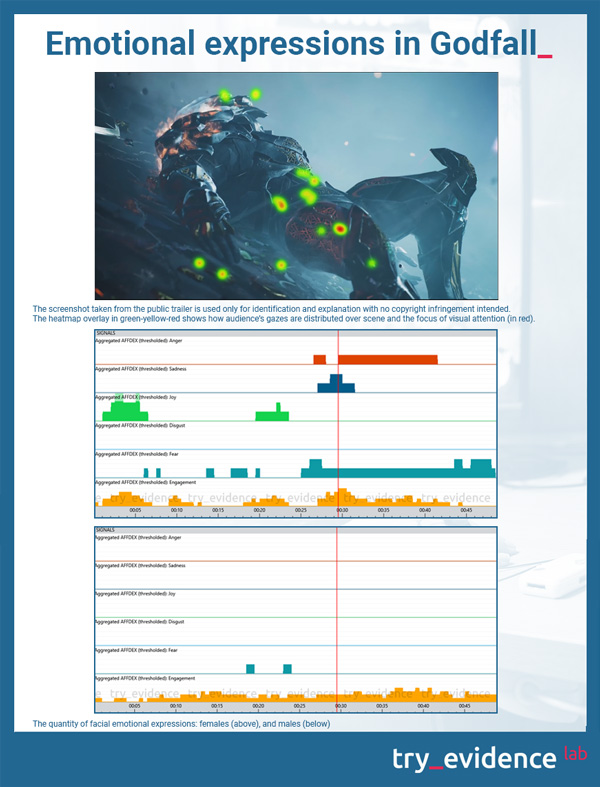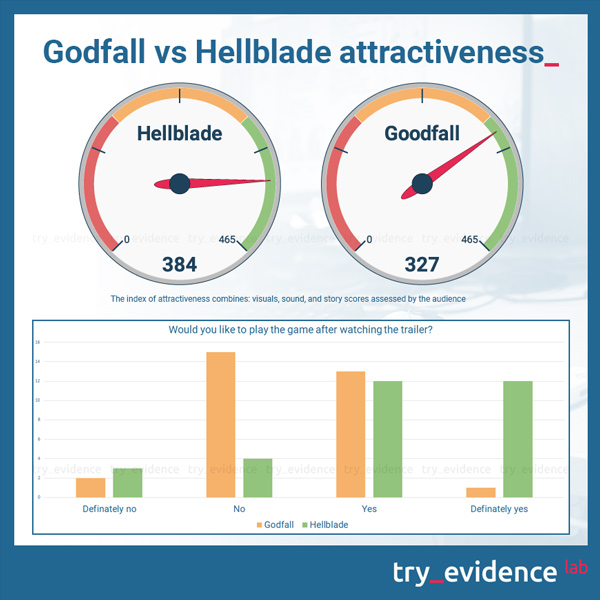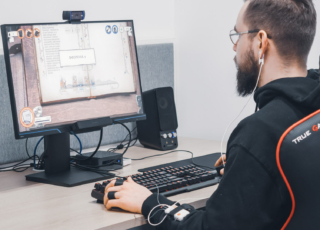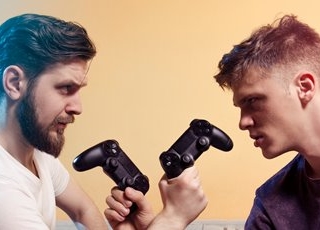The Psychophysiology of Game Trailers: Godfall vs. Hellblade II
- March 3, 2020
- Michał Dębek

In the world of gaming, the battle for player attention is tough. The trailers for Godfall and Senua’s Saga: Hellblade II are great examples of how developers work to grab players’ interest. These two titles, representing different blends of high fantasy, mythology, and raw emotion, have generated a lot of excitement in the gaming community. But beyond the epic visuals and high-stakes action, how do they impact their audience?
At Try Evidence, we explored which of these two game trailers does a better job of capturing gamers’ hearts (and minds). To find out, we used psychophysiology to measure how they impact emotions and physical responses.
Methodology
Research Methods
To gain a deeper understanding of how the trailers for Godfall (Counterplay Games; see the trailer here) and Senua’s Saga: Hellblade II (Ninja Theory; see the trailer here) impacted viewers, we combined multiple scientific methods to measure their responses. These methods allowed us to capture both physiological and emotional reactions.
We measured electrodermal activity (GSR) to track changes in skin conductance, which is an established indicator of physiological arousal. By observing these changes, we could determine the intensity of the emotional reactions viewers had to the trailers. Therefore, we identified moments that sparked heightened excitement or tension.
To explore emotional engagement, we used facial emotion recognition technology, which analyzed participants’ facial expressions while watching the trailers. This method allowed us to identify the specific emotions triggered by the trailers, such as joy, fear, sadness, or surprise. By studying these expressions, we could understand not only how viewers were feeling but also which emotional moments of the trailers were the most impactful.
We also gathered qualitative insights through surveys and interviews, asking participants about their personal reactions to the trailers. These surveys helped us gauge overall attraction, appeal, and interest in the games. Interview responses provided some valuable context and detailed opinions on what elements of the trailers worked, from visuals to storytelling, and helped us understand why certain moments stood out.
Finally, we utilized eye tracking to see where participants focused their attention during the trailers. This technique provided insight into which visuals or elements of the trailers drew the most focus and held viewers’ gaze the longest. By identifying these “hot spots,” we could determine which aspects of the trailers were the most engaging and compelling for the audience.
Research Questions
Using this approach, we found answers to key questions, such as which trailer was:
- More physiologically arousing,
- More emotionally engaging,
- More attractive,
- More appealing to younger audiences.
Moreover, we researched:
- Where the audience focused their attention,
- How long they fixed their gaze on certain elements,
- Which parts of the trailers were the most engaging, or the “hot” areas of focus.
Arousal in Godfall vs Hellblade II
Godfall turned out to be generally less arousing than Hellblade II. The Godfall trailer saw an average of 3.3 physiological peaks per minute (ppm) – 3.4 for women and 3.2 for men. In comparison, Hellblade II averaged 3.9 ppm – 4.2 for women and 3.6 for men.
Additionally, women generally exhibit higher levels of emotional empathy compared to men, influenced by both biological and social factors. For example, studies have shown that women process social cues and emotions more intensely, partly due to gender norms that emphasize emotional attunement and caregiving roles.
Godfall
Intial Arousal Peaks
The Godfall trailer’s beginning was the only moment that generated similar levels of physiological arousal across both genders. In the first few seconds, 19 out of 31 participants showed significant GSR peaks, indicating heightened engagement and excitement.
Decline in Arousal Over Time
As the trailer progressed, most respondents, particularly women, showed a gradual decline in electrodermal activity (see the graph below). This suggests that their arousal diminished over time. This pattern follows the typical structure of many trailers, where emotional intensity peaks early and then subsides as the narrative unfolds and the visuals become less striking compared to the opening moments. Not only the trailer’s design but also the viewer’s processing contributes to the reduction in arousal. As the trailer continues, viewers become more familiar with the emotional stimuli, which leads to a natural desensitization.
Psychologically, we can explain this decline in physiological response through the concept of habituation. Repeated exposure to the same stimuli over time tends to result in a decreased emotional and physiological reaction. Essentially, the initial novelty of the trailer fades, and the emotional intensity that once captured attention begins to diminish. This process is a natural part of how we engage with repetitive or predictable content, making it harder to sustain the same level of arousal as the experience continues.
Women’s Arousal Patterns
Women were generally more aroused than men during the trailer. This aligns with research showing that women often have stronger physiological reactions to emotional stimuli, such as increased heart rate and galvanic skin response. This heightened emotional engagement allows women to experience trailers more intensely. They are more likely to empathize with characters and become absorbed in the storyline. Additionally, studies have shown that women tend to report higher arousal levels in response to emotionally charged film clips compared to men. This suggests that the emotional content in trailers may resonate more deeply with female viewers, as they are more responsive to the emotional cues presented.
Gender Differences in Physiological Response to Emotional Scenes
Women’s Psychophysiological Reaction
First, women showed a physiological reaction to the scene where one of the heroes fell to the ground, appearing barely alive. In contrast, men seemed less affected by this moment, with little change in their physiological response.
This difference can be attributed to the fact that women often exhibit a greater emotional and physiological reactivity to negative stimuli, such as sadness or fear. This research has found that women tend to show higher electrodermal activity (GSR) and heart rate (HR) responses when exposed to emotionally intense scenes, especially those involving vulnerability or distress. This heightened sensitivity may be linked to socialization, which encourages women to be more emotionally attuned and expressive. As a result, women can be more likely to empathize with the character’s suffering, triggering a stronger emotional and physiological response.
Men’s Psychophysiological Reaction
Men tend to express their emotions less overtly than women. Research suggests that men display fewer facial expressions of emotion, and this is often reflected in their physiological responses. For instance, studies have shown that men do not show the same level of physiological engagement as women, even when exposed to similar emotional content.
Societal norms often dictate that men should display emotional restraint, which can result in lower physiological engagement when faced with emotional content. This socialization process may lead men to underreport their emotional experiences or to exhibit physiological responses that do not align with their subjective feelings.
It seems that such scenes do not evoke much arousal in men. So, what does?
Arousal Variations Between Genders during the Dragon Scene
One such moment was when a dragon appeared above a massive sword-like structure. This scene caught the attention of both men and women, but it caused a stronger physiological response in men. This represents a significant difference. Interestingly, though, none of the men expressed any emotional reaction to this moment, while some women did. This suggests that while the scene was visually striking for both genders, the emotional engagement it triggered varied.
Hellblade
Senua’s story showed a different pattern of arousal compared to Godfall’s, with the highest physiological response (measured with GSR)—the “peak of the peaks”—occurring in the middle of the trailer (see the graph below). This differs from the typical two-peak structure seen in Godfall and many other trailers.
Instead of starting strong and ending with another high, Senua’s trailer takes a different approach. It starts quietly and gradually builds tension. The combination of rising intensity and a musical build-up likely accounts for the arousal peaking midway through the trailer.
The arousal pattern observed in Senua’s trailer was more “rollercoaster-like” compared to Godfall. A notable peak occurred during Senua’s animalistic scream of fury. It was a moment that elicited dilated pupils and other clear signs of psychophysiological arousal. This scene, with its raw intensity, likely captured the audience’s attention and emotional engagement more effectively than other parts of the trailer.
Emotional Expressions
Although we observed relatively few facial emotional expressions in both trailers, some interesting patterns emerged that mirrored the trends seen in physiological arousal.
Godfall
As is typically observed and mentioned earlier, women were more expressive than men. The screenshots below highlight the gender differences in emotional expressions, which align with GSR data showing differing arousal levels.
Women displayed emotions such as sadness, anger, and fear when witnessing a hero fall. This is reflected in both their facial expressions and the peak in ‘engagement’ (a general measure of expressiveness). In contrast, men showed little to no emotional response to the same scene.
Hellblade
This highlighted a clear difference in emotional expression between men and women. While men experienced higher physiological arousal, they did not display much emotion on their faces. In contrast, women exhibited a wider range of emotional expressions, including joy, fear, sadness, and anger. Interestingly, one of the most joyful reactions from women occurred when the game logo appeared, which was somewhat surprising given the context.
Eye Tracking: Where Did the Viewers Look?
If you look at the screens below, you’ll notice the areas where people tend to focus the most. The lighter parts of the images show where viewers’ eyes land most frequently and where they stay the longest—these areas are mostly faces if they were in frame.
Human Tendency to Focus on Faces
Recognizing faces is a key part of how we interact socially. It plays an important role in survival and building connections. From the moment we’re born, humans show a natural preference for faces, which helps us form social bonds. This ability to recognize and interpret facial expressions is essential for creating relationships and responding to social cues. For example, faces can signal potential threats or reveal social alliances, helping us understand and respond to the world around us.
The brain even has a specialized area, called the fusiform face area (FFA), dedicated to processing faces. This suggests that humans have evolved specific cognitive and neural mechanisms to focus on faces. As a result, we instinctively look for faces and quickly fixate on them. Even with many other distractions, faces naturally grab our attention. Other eye-tracking studies back this up, showing that faces consistently draw more attention than other objects in a scene, no matter what the task is.
The image below is particularly interesting because it’s filled with so many stimuli, including the armor “burning” —type of visuals that typically grab attention. But in this case, that wasn’t the case.
The concept of scanning for faces is central here as well, and our eye-tracking study confirmed this. Despite the various distractions, people instinctively focused on faces—or even patterns that resembled faces.
For instance, in the dragon’s heads above, viewers focused on areas that resembled faces. This highlights how our brains prioritize facial information, even when a literal face is not present.
Attention-Grabing Center of the Screen
If not faces, then what? The answer is surprisingly simple: the center of the screen. This is where people tend to focus most of the time. It’s typical for us to have a central fixation bias when viewing graphics. When observing an image of a natural scene on a computer screen, people’s eyes usually move toward the center initially.
Studies have shown that, regardless of the type of stimulus, head position, initial gaze, or image placement, people’s eyes generally fixate near the center of an image when viewed on a computer screen.
One reason for this is that the center of the image might be the best location to gather information from a scene. Another is that starting at the center offers a strategic advantage when exploring an image.
Attractiveness and Appeal
Each trailer was evaluated by participants on three scales, rated from 1 to 5:
- Visuals,
- Sound,
- Story.
We combined these scores to create an index of attractiveness, and Hellblade clearly emerged as the winner.
Additionally, we asked participants whether they would want to play the game after watching the trailers. Responses ranged from “definitely no” to “definitely yes.” For Hellblade, 77% of responses were either “yes” or “definitely yes.” For Godfall, responses were split, with 45% answering “yes” and 45% answering “no.” It was clear that Hellblade was the preferred game in this group.
How Unique Is Hellblade?
How Unique Is Godfall?
Godfall seemed to leave a less lasting impression. The most memorable aspect of the trailer was the impressive armor, but the overall response could be summed up as “nice, but nothing special.” The storyline didn’t resonate with the audience and was sometimes seen as childish. Some participants even expressed feelings of boredom, despite the trailer being relatively short.
Hellblade’s and Godfall’s Trailer Showdown
It seems that Ninja Theory, the developers of Hellblade, have good reason to be proud. Their trailer was not only more physiologically arousing and emotionally impactful but also more memorable and appealing in every way. The narrative was relatively rich and meaningful, according to the participants, and the trailer convinced some of them to consider buying the game, at least in theory.
Godfall, on the other hand, was generally seen as “okay,” but our respondents seemed largely indifferent, both consciously and unconsciously. It came across as just another game trailer among many. However, it did have some success for Sony. The Playstation logo and branding in the trailer elicited a strong emotional response, particularly among younger men.
A limitation of our study is the homogeneity of the sample (N = 30). We focused on young, well-educated university students, who may not necessarily represent the core target audience for either Hellblade or, even more so, Godfall.
Copyright notice
The featured picture found in press materials to Hellblade: Senua’s Sacrifice © Ninja Theory
Godfall is published and distributed by Gearbox Publishing. ©2019 Counterplay Games Inc. All rights reserved. GODFALL™ ©2019 Sony Interactive Entertainment LLC. “Playstation Family Mark”, “Playstation”, are registered trademarks or trademarks of Sony Interactive Entertainment Inc.
Hellblade is a brand of © 2020 Microsoft. All rights reserved.


